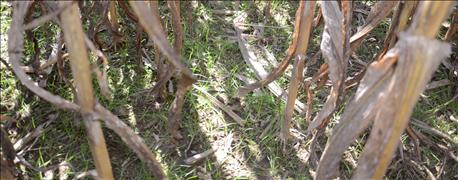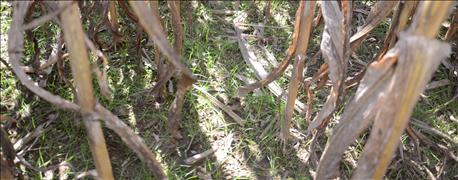
Anyone who drives rural roads knows that cover crop acreage is increasing. In most counties it’s not difficult to find fields with annual ryegrass, cereal rye or forage radishes growing after harvest, and again in the spring before planting. Many farmers understand cover crops make sense, even if they can’t explain exactly how they help.

COVER CROP ACREAGE INCREASES: The green tint in this cornfield isn’t weeds. It’s annual ryegrass, aerial-seeded in September in this field in Kosciusko County. This is becoming a common sight.
Researchers like Eileen Kladivko in the Purdue University Agronomy Department answer that "how" question using scientific techniques. She does various types of testing, including harvesting biomass from cover crop plots by cutting it off in the spring, even if it means doing it with a scissors. Kladivko collects material off each small plot, dries it in special ovens and then measures dry weights. She also does other tests to determine how cover crops are affecting nutrient levels available to crops during various parts of the season.
Kraig Bowers, agriculture instructor and FFA advisor at Fairfield High School, doesn’t pretend to be a researcher. And even though he just moved into a new ag teaching facility with lots of lab equipment, he doesn’t have everything students need to perform truly scientific research.
“We don’t have the equipment to dry forage samples after we collect them, for example,” Bowers says. “So we let them lie on lab benches and dry. What we’re doing is closer to demonstrations than actual research, but it gets kids in the field, and they are learning techniques.”
In the field

EXAMINE PLANT GROWTH: Examining spring cover crop growth and preparing to take biomass samples are Emma Lashley (left), Justin Slabaugh and Joey Gibson.
Fairfield High School established cover crop plots for the first time in the fall of 2015. Students took various types of measurements in the spring of 2016. Many are similar to the measurements researchers take to answer questions about how and why cover crops help improve soil health. Bowers hopes to continue the project into the future.
Here are nine things students are checking in cover crop plots.
1. Soil fertility. Students learn how to do basic soil testing, and to do it at a consistent time — either fall or spring. Samples are sent to a commercial lab.
2. Soil organic matter. The same 8-inch plugs used to test for phosphorus and potassium can deliver results on organic matter. Baseline levels and levels over time will be monitored.
3. Water infiltration. Students use metal cylinders and pond water to see how fast the water goes into the soil. This is one of Kladivko’s favorite demonstrations.
4. Soil tilth, or aggregation. Natural Resources Conservation Service staff help students do a slake test to determine if microorganisms are secreting materials that help hold soils together in different amounts on different plots.
5. Yield. Measuring and recording crop yield after various cover crops is part of the effort.
6. Biomass growth. Students cut what’s growing in 0.5 square meter, dry it and weight it.
7. Soil temperature. Soil temperatures in various plots are monitored with a thermometer each spring before planting.
8. Soil moisture. This involves pulling samples, weighing, drying and reweighing soil to get moisture content.
9. Soil erosion. A metal frame and watering can help students see how much soil comes off. They also weigh it.
About the Author(s)
You May Also Like




